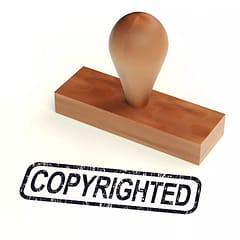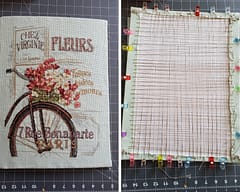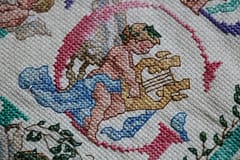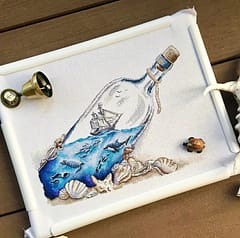Cross-Stitching Legalities: Copyright, Artwork Licensing and Copying
Thoughts on the legalities around cross-stitching
Contents
- Introduction
- Can I Make a Copy?
- What Images Can I Use?
- Public Domain Images
- Reselling Is Irrelevant
- Cross Stitching
- Computers Complicate Things
- Pattern Sellers
- The Economics of Pattern Making
- Digital Millenium Copyright Act (DMCA)
- How You Can Help
- Responsibility For Software Developers
- Oh No, it’s the “Cross-Stitch Mafia”!
- Let’s Make a Better System!
Introduction
You see an amazing picture and think “wow, that would look fantastic on my wall !”. Can you just take it?
You’re probably thinking about something on a webpage, don’t. Imagine instead it’s a framed print in a Crate and Barrel store.
Of course you wouldn’t try to steal it and most people recognize that this would clearly be theft. But while you would be stealing a frame and the print, the most valuable part of the picture is very often the image itself. That is the thing that an artist or photographer worked to produce and it’s not just yours to take.
The fact that the image is for sale in a store, gallery or on a webpage doesn’t make it any more legal to take without permission. The web version may offer little protection to prevent it, but to suggest that made it “OK” would be akin to claiming that a store assistant who left the door open and took a break gave you permission to steal.

Can I Make a Copy?
Ok, so how about if you leave it there but just make a copy? They’re not losing anything then are they? Well, yes - people pay for rarity and exclusivity and if you are just making copies for free then it devalues the piece and why would anyone pay for something if it was ok to get it for free?
What Images Can I Use?
Whether you make a photocopy of a picture, take a photo of it or make a pattern and produce a piece from it, you are reproducing the image in one way or another. Are you allowed to do that?
There’s a quick and easy default answer: no.
If you don’t know that you are specifically allowed to use an image, then you probably aren’t. How do you know if you can?
It comes down to copyright - if you create the picture then you own it and can do what you want with it, reproduce it, sell it, give it away, whatever you want. There is an exception which is if you are paid to do it (maybe as part of your job) and the terms of the contract state that you assign ownership and copyright to the person who is paying you to take it.
Public Domain Images
Some people want their images to be used and generously make them available for other people to use by placing them in the public domain. Sometimes these are limited to academic or editorial use only but others allow commercial use where you could make products for resale based on those images. There are many websites that make free images available. Look for Creative Commons CC0 licensed images which can be used for commercial use.
Reselling Is Irrelevant
Some people think that it only matters if you intend to make money from the image but this doesn’t really change whether something is legal or not. If you steal something from a store, it doesn’t absolve you of guilt if you give it away instead of selling it. Obviously, if you have a web-store and are advertising things for sale that you do not have permission to use then it’s much easier to find out about it than if you have just printed off a picture at home and put it on your wall. It’s also deemed to be more egregious and so is often pursued more vigorously by those protecting their copyright.
Cross Stitching
How does all this relate to cross-stitching?
Well, patterns and charts are all about the image - you are taking a picture, creating a pattern to serve as the instructions to reproduce that and then using that pattern to reproduce the likeness of that image in another medium. It’s not really any different to taking a photo of it, it just takes a lot longer.
When you purchase a pattern, part of what you are paying for is the right to reproduce that image - that is the whole purpose of a pattern after all. Some people claim that you are only allowed to reproduce it once and if they impose that restriction as part of the contract of sale that you are made aware of before purchase then it is true but most of the time the piece is yours and you can so what you want with it. That means you can sell it, donate it, give it away or whatever you want. You can also make more pieces from the same pattern but what you can’t do is ‘mass produce’ them. The nature of cross-stitching as a hand-crafted product means the economics rarely make this an issue and mass production refers to mechanized duplication.
The pattern itself is of course different to a the piece made from the pattern. You pay for all the materials and the work put into making the piece and it’s yours but your don’t ‘own’ the copyright of the pattern any more than you own the copyright of a book you purchased - you just bought a copy to read / use. This means you can’t reproduce it and distribute copies to others but, like a book, you are perfectly OK selling it or passing it on to someone else after you have used it as long as you don’t make and keep a copy for yourself (and it doesn’t matter whether you charge money or not when it comes to copyright).
Most of the time discussion of copyright related to cross-stitching is focused on the pattern because they are the thing that is ‘copyable’ and most people have no means of mass-production. Most people consider it OK to make a working copy to mark off stitches and to protect against the paper wearing out while you work on it (some pieces take years to stitch after all!)
Computers Complicate Things
Of course, if we’re talking about printed paper patterns that you purchase from a craft store then everything is clearer and simpler. But as is often the case, laws that were created and established long before technology change need to be adapted to fit what is now possible and often it results in confusion or contradictions.
What about a pattern that you purchase online as a PDF file? You are obviously making a copy of it if you print it out but you already made an electronic copy of it when it’s downloaded onto your computer. Your computer copies it into memory when you open it and then copies it to the screen to display it. You make a copy if you back it up to your cloud storage to protect your files or access it from another device. You probably already copied the image in the same way when you were just browsing the web.
Should you be expected to purchase a pack of licensed just to be able to make basic use of a pattern? I think that would be ridiculous.
Pattern Sellers
It’s not just about how we use the pattern though - there’s also the issue of the pattern sellers.
It’s a sad fact that not everyone in the world is honest. Some people seem happy to profit from the work of others and there appears to be a thriving black-market of people selling patterns based on images they have not licensed or reselling other people’s patterns that they have obtained.
One reason for this is that patterns can cost a lot of money and also it’s very easy to do.
If people are willing to pay $20-$125 for a pattern and at the same time you can obtain software to create patterns for $50-$100 then it doesn’t take a lot of math to figure out that you could make money by creating and selling patterns.
The Economics of Pattern Making
The economics of most businesses rely on three things:
- Source Materials
- Manpower and Effort
- Tools and Equipment
The source material for pattern-making are the images which may or may not be licensed artwork. If they are free public domain images, then there is no cost to the pattern maker so don’t factor into the pricing (and you should expect charts based on them to be cheaper). For licensed artwork the pattern maker could deal with artists directly or go through some art licensing company to obtain the images. These might charge somewhere between 15% to 25% of the sale price but may only pay out 50% of that to their artists. So, on a $20 pattern, the licensing company might take $4 and the artist get $2 of that - perhaps not as much as you might expect. It’s one of the reasons you often see little difference between patterns based on licensed art and patterns based on freely available public domain art (e.g. old masters) - the proportion paid to the artist isn’t likely a significant part of the price.
Most of the pattern cost really goes on a combination of manpower and effort or tools and equipment. You obviously need a computer (doesn’t everyone just have one anyway nowadays?) and some chart-making software. Even if you pay $100 or $200 for the software, you could create hundreds or even thousands of patterns using it so the amount it would add to the cost of any single piece would be negligible (but if you want to create an odd piece for personal use, buying software might be an expensive option and it would make more sense to use a service).
So that leaves manpower. I’ve seen claims from some that it takes them weeks or months to create a pattern but I’m very skeptical of that, especially since that was how long it took for us to build a complete app and website to make it possible for anyone to do it. Most, if not all, of the work is really done by the software. Some designers may add a few tweaks to the result but I don’t believe that someone genuinely sits down for 8 hours a day, for a month or more, changing odd stitch colors on a single chart except for very specialist designs.
I showed in a previous article about the Secret Truth Behind Cross-Stitch Chart Design that it isn’t necessarily a time consuming process. Checkout the video and you can see it only takes a couple minutes to make a high quality pattern from an image.
So, with the right software, you could quite easily produce a dozen or more patterns in an hour (and you should be good at it if you’re doing it a lot). Each pattern could be sold multiple times for $20-$30 each with a few dollars going to licensing each time. You could also charge for creating custom charts as well - if you charge $100+ and you spend 15 minutes on it, that’s still an amazing hourly rate to charge. Some claim they do make changes after the computer has done it’s part but I’m yet to see any before-vs-after pieces to compare and to demonstrate the value-add from the few stitches they have tweaked. Maybe someone could demonstrate an example?
Of course for a legitimate business there are other costs and expenses - running a website, providing support and book-keeping / remitting taxes … but also of course - profit.
Note that it’s worth pointing out that there is some over-use of the term “designer”. I don’t consider someone using an app to convert an image to a chart a “designer” in the same way that someone who creates a design from scratch using the medium to do it. Kudos and respect to the true designers who create their art from scratch specifically for cross-stitchers, I’m not talking about you people.
But now you see why there are so many unlicensed patterns for sale on sites such as eBay or Etsy. The surprising thing is that using licensed artwork doesn’t make a huge difference to the end prices but as a percentage, it means the people who refuse to pay them can undercut the legitimate sellers and of course the reason the licensed artwork is licensed in the first place is usually because it is good and more likely to sell and therefore more appealing to use.
Even worse is if they take the the patterns that others have made and re-sell those so they don’t even need to use any software or do any effort - truly, zero cost.

real piracy isn’t quite so cute
Digital Millenium Copyright Act (DMCA)
Of course people who use someone else’s images are violating copyright. But who exactly is using them and how do you stop them? Imagine someone uploads a copyrighted image to some internet service and that service publishes the image in good faith expecting its users to only upload images they have the rights to (as per it’s terms of use). Who’s fault is it? Imagine for a second that the service should be guilty of what one user did - would that work? No, it would cripple half the internet! Any site that allowed user-submitted content - Imgur, Facebook, Twitter, Google, YouTube … you name it, they could all be shut down. The reason they are not is because of a rather well conceived law called the Digital Millenium Copyright Act (DMCA) which is based on some globally agreed copyright treaties. It actually raised the penalties for companies that wilfully flout copyright but at the same time protects the majority of well-intentioned sites from abuse (possibly by malicious users who could otherwise conspire to have their own work copied in order to sue).
If you find your work on someone else’s site, you may be outraged but the first thing to remember is - they may not be violating your copyright intentionally or wilfully. A user may have violated their terms by uploading an image they do not have permission to use but there is simply no way to verify the ownership of the majority of images in advance. So keep calm, be respectful - often all that is needed is to notify someone of what has happened.
Many sites will provide a more structured process to handle things and you can submit what is known as a DMCA Takedown Request. This means you make a sworn statement that the image belongs to you and you want it removed. The company can refuse if they believe you are wrong or, as is more often, they can allow the guilty user to contest it if they want the legal liability of doing so. If it really is an unlicensed image, there is a very good chance that most decent companies / website owners will be more than willing to remove the errant content in a reasonable time-frame. By removing it, they exercise a provision of the DMCA act that protects them against being sued for copyright violation. But the DMCA also make false claims actionable - so don’t go “takedown happy” demanding that sites remove content that isn’t really yours to claim because the sworn statement means you could be liable if you are making a false claim.
It’s a well thought out system - people can have unlicensed use of their copyrighted material removed without huge legal costs and without the court systems being deluged with internet-copying related lawsuits.
How You Can Help
First of all - think before you use an image. Is it yours? Do you know who’s it is? Have they licensed it to be used or shared? Just because you have seen other people share the same image doesn’t mean you can do it to.
For site owners - make your stance on copyright and your terms of use clear and don’t let user protests or complaints sway you from doing what is right or legal. If you are told about something that is copyrighted then you should remove it.
But not everyone will do the right thing when there is money to be made.
It goes without saying that you really shouldn’t buy from sellers who are obviously selling other people’s work and profiting from it. If you do, then you are contributing to the problem. Buy patterns from legitimate sources who are doing things properly. It supports legitimate business and it supports artists.
But at the same time, don’t be fooled into overpaying for charts and supporting artificially high prices. I personally think some of the excessive prices contribute to the copying and illegal sharing - if prices are more reasonable, there is much less incentive to steal.
Responsibility For Software Developers
As we’ve already seen, the same software to create a pattern from an image can be used in many different scenarios:
- Creating a pattern from your own image to stitch
- Creating patterns from your own image for resale
- Creating patterns from licensed images for resale
- Creating a pattern from an unlicensed image to stitch
- Creating patterns from unlicensed images for resale
The top three are legitimate. The bottom two are not. The software used is the same in each case - is just a tool, like many others, that people can use legitimately or misuse.
But tool makers can help too.
As a new entry into the world of cross-stitch pattern-making software we knew copyright was a hot topic in the community and of course do all we can to abide by all the laws and respect other people’s copyright as we hope people will respect ours. We also have some ideas to improve the ecosystem
Oh No, it’s the “Cross-Stitch Mafia”!
The image of cross-stitching to many is one of friendly old grandmothers who you just know also bake great pies. But holy cow - we didn’t expect the “cross-stitch mafia” to come and try and shut us down the day after we launched!
In the space of 24 hours we were publicly being accused of encouraging and facilitating theft, of actually stealing other people’s charts and I had a whole day of someone sending me facebook messages demanding that I admit that we were intending to steal their patterns / images. They didn’t care what answers we gave about how we provided copyright protection, they just wanted us to shut our service down. We also got an email from someone apparently off facebook (but with a brand new email address and who didn’t exist, hmm), basically again wanting us to say that “our system is for people to steal images”. It felt like entrapment. It was all a bit surreal.
Let me state as clearly as I can: these are outright lies, we are doing everything we can to combat copyright violation and are certainly not encouraging or condoning it.
The people who made these accusations all make money selling charts and I think they feel threatened by someone offering a better service at a significantly lower price. We’ve also been keen to share knowledge about the chart-making process and show how easy it can be and how little time it really takes. If you rely on mystique and perpetuating myths about it being a lengthy time-consuming process to justify high prices, I can see how that might be threatening.
As someone “new” to the cross-stitching world (only really aware of it through my wife’s hobby) it was immediately apparent to me that this was an ecosystem that was a little behind the times and in need of a technology catch-up and that little had been done to invest in new technology or improving the market.
Most importantly, it seemed that people had become accustomed to overpaying for cross-stitch charts for a long time - helped by certain voices actively perpetuating the idea that it was difficult and time consuming. The irony is that the people accusing us of putting artist’s incomes at risk have really done little to develop better protection for their own patterns or improve anything - just keep the status quo of high prices.
This inevitably leads to an explosion of unlicensed patterns and illegal sharing.
It would be easy to look at a niche market and just slip in to charge what the going market rate for things are. If people are used to paying $30 for a pattern, we should charge the same … right?
Maybe, if we just wanted to make money. Hey, we do want to make some money, but we want to do more than that - we really want to try and improve the ecosystem which means being disruptive.
Let’s Make a Better System!
Here’s what we’re working to do and how we want to help improve protection for artists and give a better deal to both them and to stitchers:
Why do people buy unlicensed charts? The only real reason is because they are cheaper. If people could buy legitimate charts from reputable sources I think they would but people don’t like being ripped off or over-charged.
How can we stop that? Easy - sell our charts cheaper.
Does that mean paying less money to artists? Not necessarily - I’d much rather pay an artist $5 on a $10 pattern than see them only getting $2 from a $20 sale. The artist wins, the customer wins. The layers of middlemen and profiteers lose. Too bad, so sad.
How can you do this and still make money? By investing in new technology to automate things. You can make your own patterns, you don’t need to pay us an exorbitant rate to do it for you. We use cloud technology to lower our own costs and pass on the savings. At the same time it means customers get more choice - instead of the pattern being the size the person generating it picked, why not let you make your own from the image at the size and thread-count that you want?
Right now our main focus is on making the custom charting service available for end users - stitchers who want to make patterns of their own images to work on themselves whether that is a holiday snap, their spouse, grand-kids or beloved pet.
But, we’ve designed and built the system so that others will be able to use it to easily create their own stores - an artist could make their images available through the system and be paid directly for the sales or a store owner could use the images that artists provide them to manage a store and pay them a license. No web servers to manage, no payment processing systems to setup, nothing to do except drag and drop their images to upload them.
But some people will still steal charts! Maybe, but we can make it more difficult. By having an online and on-demand chart making service rather than selling the exact same pre-generated static PDF file to every person it’s easier to do things like generate the charts with the licensee information embedded to discourage the casual sharing that often leads to widespread piracy. Reasonable prices will always help encourage people to purchase their own copy.
But why even have sharable PDF files for charts? That harks back to printing things off - isn’t the paperless future here yet? There will probably still be people that want to do that for the immediate future but if using an online viewer to chart from and track progress takes off we can maybe get away from using PDF files at some point. It’s much easier to protect a service being accessed to ensure it’s by legitimate users than it is to protect an file that is downloadable and sharable.
We don’t want to be overbearing and controlling though. We want the system to be used because it provides a better, more convenient and useful service. Rather than trying to coerce a general PDF viewer for use with cross stitching, we see value in providing a viewer that is tailored specifically to the needs of a stitcher and will help them quickly select thread colors, highlight stitches, navigate a pattern and track their progress.
We see a future where if someone tries to create a chart from an image that our system recognizes as licensed artwork it will direct them to purchase the pattern from the artists original instead and pay them accordingly.
What do you think? Is this crazy pie in the sky or is it just an inevitable consequence of technology changing and being applied to a niche market long overdue for a much needed overhaul? We’d love to hear your feedback and ideas or suggestions on how we can make things better and what you would like to see developed.
As always, please like our videos and follow our us on our Thread-Bare Stitching Facebook Page or Thread-Bare Stitching Pinterest Channel for news and future articles.





